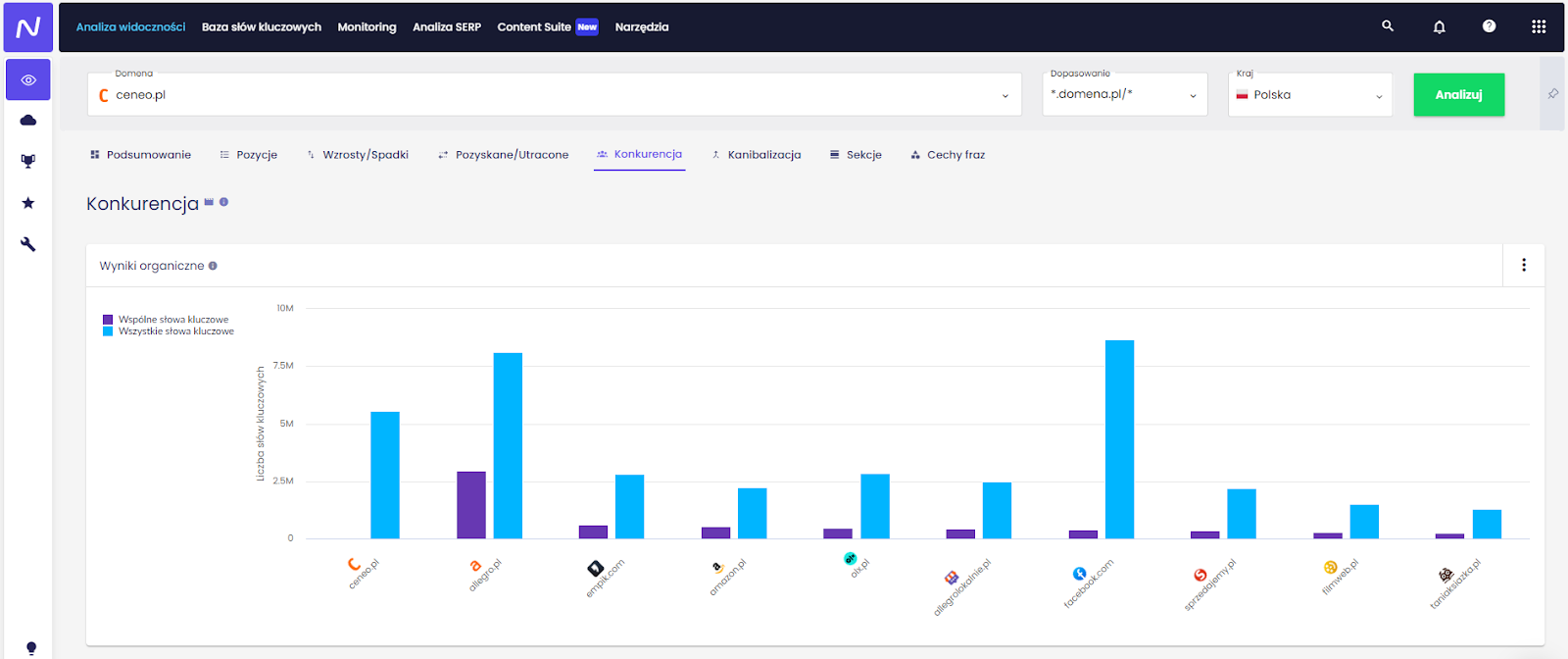When running an online business, you always need to consider your competition – who they are, what they are doing, and how those activities translate into results. Learn how to approach such an analysis and what to include in it to get a complete market picture. Remember, the competition doesn’t sleep and you shouldn’t sleep through the opportunity to become a leader in your industry either!
Competitive analysis in marketing – what is it?
.
It is nothing more than monitoring the activities of your competitors not only on your own website, but also outside of it. It is also the starting point for undertaking any strategic marketing efforts for a business.
Competitive analysis in online marketing allows you to:.
- understand the situation in the industry,
- monitoring changes occurring in the market,
- tracking and anticipating the actions of competitors,
- getting inspiration,
- sourcing benchmarks,
- drawing conclusions about one’s own actions,
- gaining a competitive advantage,
.
.
.
.
.
.
.
Competitive analysis is not a one-time activity. It is important to perform such an analysis at the beginning of your journey in online business and periodically, such as quarterly. This will give you an idea not only of how your own business is developing in relation to the competition, but also,how and whether the marketing strategy of industry rivals is changing.
Competition analysis in content marketing
.
There are more and more brands, stores on the Internet, and consequently a multitude of ideas and strategies to attract user attention. Standing out from them is a real challenge. On top of all this, there are also Google’s guidelines and algorithm updates, which now highly rates sites that offer real value to the viewer – including content. Just having content on the site is not enough.
Do I need this?
.
The answer is simple: YES. Whether you are running a large online store or a small business just starting out. Without a competitive analysis, you don’t have a full understanding of the current market situation, you don’t know what engages your target audience or how to attract them and, importantly, how to keep them for longer so they become loyal customers and brand ambassadors.
Where to start a competitive analysis?
Apply it strategically and comprehensively. Ask yourself, what do you want to learn through this analysis? The format? Any format! But remember to make it convenient for you to go back to the data and conclusions and compare them with each other over time.
A handful of tips to get you started:.
-
- Determine your industry.Precisely placing your business in a market context is the key to authoritative results and accurate conclusions.
- Establish your competitors: business and content competitors.
- Adjust your analysis criteria.What do you want to find out? You can perform analysis from different angles!
- Use the tools. Don’t rely on guesswork – there’s no better proof than hard data and numbers!
- Draw conclusions and set a strategy for action.
- Realize assumptions and aim to win!
- Repeat the analysis! That’s right, cyclicality of analysis is the cornerstone of marketing efforts – even if you’ve already reached the top.
.
.
.
.
Competitive analysis in marketing step by step
.
How to find your competitors?
.
Do it with your head and focus on quality rather than quantity. Choosing the largest online store on the market that offers a wide range of renovation and finishing products, while your business specializes in selling paint and wallpaper will not be a good idea. You need to find the golden mean – choose between 3 and 6 competitors, but selected according to precise criteria. Pay attention to:
- branch,
- products/services offered,
- target group,
- prices,
- scope of activity,
- size of service,
.
.
.
.
.
.
Tools will be helpful in selecting competitors. In Senuto you have the ability to quickly verify your competitors in terms of visibility in Google. The data is presented in the form of a chart and a comparison table. This makes it easy for you to verify and select the right sites for analysis.

.
Screen of a chart from the Competition module in Senuto. Source: senuto.com.
.
Don’t forget about content competition – it’s the real shark of search engine visibility and traffic. Look out for who rules in Google for informational and long-tail phrases related to your industry and the products/services you offer. This is also where you can take advantage of tools and… social media! This is a valuable source of information about your target audience – check what pages they like, what they share. Pay attention to what content published on social media by brands similar to yours looks like. What tactics are they using? What are they sharing and in what form?
Business competitors are brands similar to yours – doing business in the same industry, offering similar products or services. You are characterized by the same target audience. Business competition for a beauty store will therefore be another beauty store offering products for the same target group, at a similar quality and price. Content competition, on the other hand, are all portals that post content on their sites that could just as well be on your site. Content competition for a cosmetics store, for example, could be a well-read site of a beauty blogger who writes about skin care and makeup trends..
SEO visibility
.
Start your content marketing competitive analysis by verifying the visibility of your content section. Remember to analyze your own site as well – this will allow you to understand the context and position your business among your competitors’ activities.
Check how many key phrases your competitor’s content section – blogs, advice sections and articles – is positioning for. Pay attention not only to the number of total phrases, but also to those in TOP3 and TOP10. Check which articles are displaying high and which are generating a lot of traffic for the site. This will give you an idea of how extensive the content section of your competitors is, what topics they cover, and whether the content they publish is valuable and tailored to their target audience.
Remember Topical Authority – Google ranks higher pages that are filled with valuable content, centered around the site’s topic..
User engagement
.
Content has power and can work business wonders. However, it must be created thoughtfully. When evaluating user engagement, what matters is not how much content you create, but whether you create it taking into account the needs of your target audience. Content that is of interest is often shared on the Web. Verify whether your competitors are creating content that clicks – is shared on social media and carries out into the world, generating viral reach. Because why create content that no one reads or finds valuable?
Check out what articles gather the most reactions. Is there something unique about them? What tactics have been used here? Do an overview like a real researcher and pull out the most interesting stuff. Competitors’ activities are excellent inspiration..
Mention of the company on other pages
.
Content is not only what you publish yourself or your competitors, but also what others say about your business. The more they say (preferably positively), the greater the power and recognition of your brand. And that, in turn, translates into marketing success. Find out if and what others are saying about you and your competitors.
Analyze entries from a content and visual angle
.
Competitive analysis in content marketing is not only based on hard data from tools. It’s time to move on to the real content weapons – tactics.Tactics are the means of executing content that effectively engages the target audience. Pay attention to the following areas:
- Content aspect – check what topics your competitors cover on their blogs, what do they write about? Put yourself in the role of the reader. How is the title of the text structured? Did the content of the post answer all your questions? Do you feel that the topic has been exhausted? Or, however, was something missing from the article? Content often goes hand in hand with the length of articles – longer materials contain more content, which often inspires trust and interest not only in users, but also in Google. This is a signal for you to build your articles with real content value. Competitors don’t give the reader all the answers? This is your chance to become an industry expert!
- Identify forms of content -are you publishing content cycles that have an established form (subject matter, title construction, consistent segmentation, graphic templates, order of information in paragraphs). Are any of the cycles better at generating traffic, links, social interactions, and if so, why? What is so interesting about them? Does the content allow the user to act, i.e., are there clickable elements with appropriate CTAs calling for action?
- Webwriting – how the content should look depends on where it is distributed and how it is read. Pay attention to the length of the content, the level of optimization of the content for SEO, and whether clear segmentation of the text is used. Also important is, uniqueness, linguistic and stylistic correctness, and linking to other articles.
- Visual aspects -does the content include graphics, infographics, featured quotes, downloads, video, or perhaps charts, tables? On the Internet, the visual side is of great importance. Nearly 80% of users (source: Nielsen Norman Group) scan text with their eyes, rather than reading it from cover to cover –text alone is not the life of content.
- Effectively promote your offerings -content can accomplish and support your business goals, but it needs guidance to do so. Observe whether linking to categories and products has been applied, whether there is a CTA (in the form of banners or woven into the content). Attractive product presentation is also important (e.g., product boxes and carousels, photos with product pins) – remember that on the Internet we are all visual people.
.
.
.
.
Tactics is a mine of inspiration! Pull out the most interesting and effective ones used by your competitors and see if they translate to your business. Tactics can also be the impetus for you to create original solutions and strategies!
It is said that a good text will defend itself – not on the Internet. Here the user comes across thousands of distractions. If he doesn’t find what he is looking for (information, entertainment, often both) on your site, he will go to your competitors. Don’t let him do that!
Don’t_guess! Always be one step ahead of the competition and don’t let yourself get ahead!
Competitor analysis in online marketing is undoubtedlythe foundation of all promotional, branding and strategic activities. While the result of analysis is creative strategies, it is important not to guess, but to rely on specific sources and through data measure the effectiveness of the actions taken. At Harbingers we convert creativity into KPIs, which allows us to monitor our actions, verify their effectiveness and draw conclusions. We know that the success of a cohesive, thoughtful and tailored Content Marketing Strategy is based on in-depth analysis based on reliable data.To outperform your competition, you need to take off – competitive analysis is the perfect drive for the machine to achieve your business goals through content.
 Agnieszka Surówka
Agnieszka Surówka